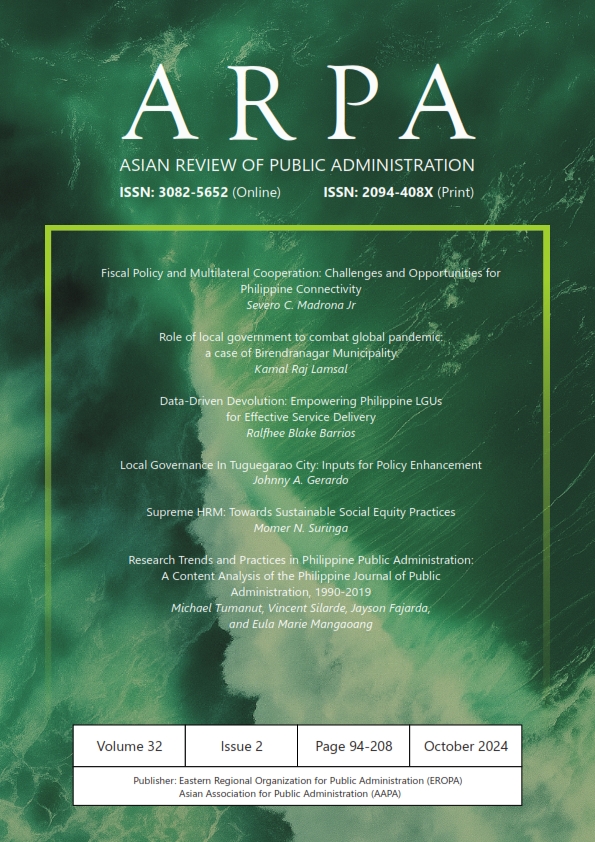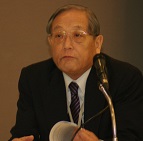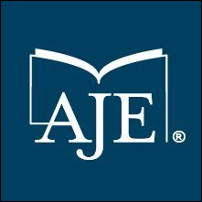SUPREME HRM: Towards Sustainable Social Equity Practices
DOI:
https://doi.org/10.64423/arpa.v32i2.17Keywords:
SUPREME HRM, PRIME HRM, Sustainable HRM, Sustainable Social EquityAbstract
SUPREME HRM refers to a Sustainable Program for Reinforcement in Establishing Meritocracy and Excellence in Human Resource Management (SUPREME HRM). It is a product of an empirical study with a theoretical analysis that integrates the Philippine Civil Service Commission’s Program to Institutionalize Meritocracy and Excellence in Human Resource Management (PRIME HRM) with contemporary tenets in Sustainable Human Resource Management (SuHRM). This new framework promotes Sustainable Social Equity (SSE) practices by managing strategic employee engagement and sustainable employee experience. This suggests a balanced integration of PRIME HRM and SuHRM, creating an ideal contemporary human resource management (HRM) culture to address SSE issues. Based on sustainable processes theory, SUPREME HRM offers a complete way to carry out HRM to improve employees’ experiences through SuHRM and increase their engagement in the government sector through PRIME HRM. In addition, this novel approach provides an equilibrium between process-oriented and people-oriented programs, integrating work and life for the government workforce in the Philippines. Thus, the dynamics of SUPREME HRM significantly impact the personal and social development, economic acumen, and environmental consciousness of its human capital to improve their experiences of a world-class bureaucracy.
References
Adom, D., Hussein, E. K. and J. A. Agyem. (2018). Theoretical and conceptual framework: mandatory ingredients of quality research. International Journal of Scientific Research 7 (1): 436–41.
Afacan Fındıklı, M., Yozgat, U., & Rofcanin, Y. (2015). The central role of strategic human resource practices (shrps) is to examine organizational innovation and knowledge management capacity. Procedia - Social and Behavioral Sciences, 181, 377–387. https://doi.org/10.1016/j.sbspro.2015.04.900
Antonenko, P. D. (2015). Instrumental value of conceptual frameworks in educational technology research. Educational Technology Research and Development, 63(1), 53–71.
Argento, D., Broccardo, L., Truant, E. (2022). Faces of sustainability paradox. Meditari Accountancy Research, 30(7), 26–48. https://doi.org/10.1108/medar-10-2020-1051
Aslanertik, B. E., & Çolak, M. (2021). The link between sustainability reporting and core characteristics of Sustainable Human Resource Management. International Journal of Contemporary Management, 57(4), 15–24. https://doi.org/10.2478/ijcm-2021-0010
Bal, P. M., & De Lange, A. H. (2014). From flexibility in human resource management to employee engagement and perceived job performance across the lifespan: A multisample study. Journal of Occupational and Organizational Psychology, 88(1), 126–154. https://doi.org/10.1111/joop.12082
Baykal, E. (2020). Digitalization of Human Resources. Tools and Techniques for Implementing International E-Trading Tactics for Competitive Advantage, 268–286. https://doi.org/10.4018/978-1-7998-0035-4.ch013
Benn, S., Teo, S. T. T., & Martin, A. (2015). Employee participation and engagement in working in an environment. Personnel Review, 44, 492-510. doi:10.1108/PR10-2013-0179
Bocean, C. G., Nicolescu, M. M., Cazacu, M., & Dumitriu, S. (2022). The role of Social Responsibility and Ethics in employees’ well-being. International Journal of Environmental Research and Public Health, 19(14), 8838. https://doi.org/10.3390/ijerph19148838
Bowen, G. A. (2009). Supporting grounded theory with an audit trial: An illustration. International Journal of Social Research Methodology, 12(4), 305-316. doi:10.1080/1364557080215619
Brassey, J., Christensen, L., & Dam, N. v. (2021, March 1). Essential components of a successful L&D strategy. Retrieved from McKinsey & Company: https://www.mckinsey.com/capabilities/people- and-organizational-performance/our-insights/the-essential-components-of-a-successful-l-and-d- strategy
Castro, A. A., & Edralin, D. M. (2018). Predictors of humanistic sustainability HRM practices. DLSU Business and Economics Review, 27 (2), 130-146. Retrieved from https://animorepository.dlsu. edu.ph/faculty_research/3460
Chun Tie, Y., Birks, M., & Francis, K. (2019). Grounded Theory Research: A design framework for novice researchers. SAGE Open Medicine, 7, 205031211882292. https://doi.org/10.1177/2050312118822927
Civil Service Commission. (2012). Program to Institutionalize Meritocracy and Excellence in Human Resource Management (PRIME-HRM). Memorandum Circular no.3 (2012). Manila.
Civil Service Commission. (2014). Adoption of HR Maturity Level Indicator for Human Resource Management Systems in the Public Sector. Memorandum Circular No.13 (2014). Manila.
Civil Service Commission. (2016). Program to Institutionalize Meritocracy and Excellence in Human Resource Management (PRIME HRM) Enhanced Maturity Level Indicators, Memorandum Circular No. 24 (2016). Manila.
Civil Service Commission. (2021). Program to Institutionalize Meritocracy and Excellence in Human Resource Management (PRIME-HRM): Revised Guidelines on the Conferment of HR Recognition and Award. Memorandum Circular No. 1 s. 2021. Manila
Civil Service Commission. (2022). CSC Guidelines in Policy Development. Office Memorandum No. 1. 2022. Manila.
Corbin, J., & Strauss, A. (2008). Basics of Qualitative Research (3rd Ed.): Techniques and Procedures for Developing Grounded Theory. https://doi.org/10.4135/9781452230153
Creswell, J. (2009). Research Design: Qualitative, Quantitative, and Mixed Methods Approaches (3rd ed.). SAGE Publications Inc.
Creswell, J. w. (2014). Research Design: Qualitative, Quantitative, and Mixed Methods Approaches (4th ed). SAGE Publications.
Creswell, J. W., & Clark, V. L. P. (2011). Designing and conducting mixed-methods research (2nd ed.). Thousand Oaks, CA: Sage Publications.
Dabić, M., Maley, J. F., Švarc, J., & Poček, J. (2023). Future of digital work: Challenges for sustainable human resource management. Journal of Innovation & Knowledge, 8(2), 100353. https://doi.org/10.1016/j.jik.2023.100353
Davidescu, A. A., Apostu, S. A., Paul, A. & Casuneanu, I. (2020). Work flexibility, job satisfaction, and job performance among Romanian employees: Implications for Sustainable Human Resource Management. Sustainability, 12(15), 6086. https://doi.org/10.3390/su12156086
Ehnert, I., & Harry, W. (2012). Recent Developments and Future Prospects on Sustainable Human Resource Management: Introduction to the Special Issue. Management Revue, 23(3), 221–238. http://www.jstor.org/stable/41783719
Ehnert, I., Parsa, S., Roper, I., Wagner, M., & Muller-Camen, M. (2015). Reporting on sustainability and HRM: A comparative study of sustainability reporting practices by the world’s largest companies. The International Journal of Human Resource Management, 27(1), 88–108. https://doi.org/10.1080/09585192.2015.1024157
Elrehail, H., Harazneh, I., Abuhjeeleh, M., Alzghoul, A., Alnajdawi, S., & Ibrahim, H. M. (2019). Employee satisfaction, Human Resource Management practices, and competitive advantage. European Journal of Management and Business Economics, 29(2), 125–149. https://doi.org/10.1108/ejmbe-01-2019-0001
Esen, D. & Süral Özer, P. (2020). Sustainable Human Resources Management (HRM): A study in the Turkey context and developing a sustainable HRM questionnaire. International Journal of Management Economics and Business, 16(3), 550–580. https://doi.org/10.17130/ijmeb.798548
Fechete, F., & Nedelcu, A. (2019). Performance management assessment model for sustainable development. Sustainability, 11(10), 2779. https://doi.org/10.3390/su11102779
Foley, G., Timonen, V., Conlon, C., & O’Dare, C. E. (2021). Interviewing as a vehicle for theoretical sampling in grounded theory. International Journal of Qualitative Methods, 20, 160940692098095. https://doi.org/10.1177/1609406920980957
Foucrier, T., & Wiek A. (2019). Process-oriented framework of competencies for Sustainability Entrepreneurship. Sustainability, 11(24), 7250. https://doi.org/10.3390/su11247250
Gembu, S. E., and Dickson, C. N., Apikins, W., & Samuel, I. A. (2019). Recruitment, selection, and placement of human resources by the International Civil Service Commission. International Journal of Sciences: Basic and Applied Research, 48(4), 188-200. Retrieved from https://www. gssrr.org/index.php/JournalOfBasicAndApplied/article/view/9355
Glaser B. G. (1978). Theoretical sensitivity. Mill Valley, CA: Sociology Press.
Glaser, B. G., & Strauss, A. L. (1967). Discovery of Grounded Theory. Aldine Publishing Company. Retrieved February 1, 2023. https://ethnographyworkshop.files.wordpress.com/2014/11/glaser- strauss-1967-the-discovery-of-grounded-theory-strategies-for-qualitative-research-unknown.pdf
Gooden, S. T., & Wooldridge, B. (2007). Integrating social equity into a Core Human Resource Management Course. Journal of Public Affairs Education, 13(1), 59–77. https://doi.org/10.1080/15236803.2007.12001467
Gubrium, J. F., & Holstein, J. A. (1998). Narrative Practice and Coherence of Personal Stories. The Sociological Quarterly, 39(1), 163–187. https://doi.org/10.1111/j.1533-8525.1998.tb02354.x
Harrington, B. & Ladge, J. J. (2009). Work–life integration: Organizational Dynamics, 38(2), 148–157. https://doi.org/10.1016/j.orgdyn.2009.02.003
Holstein, J. A., & Gubrium, J. F. (1995). The active interview. Thousand Oaks: Sage.
Indiparambil, J.J. (2019). Strategic Sustainable Human Resource Management: Shifting Paradigms of Personal Managerial Trends. International Journal of Business and Management Invention (IJBMI) 8 (3), 65-70. https://www.ijbmi.org/papers/Vol(8)3/Series-2/K0803026570.pdf
Jankelová, N. (2021). The key role of strategic and people-oriented HRM in hospitals in Slovakia in the context of organizational performance. Healthcare, 9(3), 255. https://doi.org/10.3390/healthcare9030255
Kehoe, R. R., & Wright, P. M. (2010). The impact of high-performance human resource practices on employees’ attitudes and behaviors. Journal of Management, 39(2), 366–391. https://doi.org/10.1177/0149206310365901
Kirpik, G. (2020). The concept of employee happiness in human resource management: A systematic literature review. Business & Management Studies: An International Journal, 8(3), 2750–2775. https://doi.org/10.15295/bmij.v8i3.1517
Kramar, R. (2013). Beyond Strategic Human Resource Management: Is Sustainable Human Resource Management the Next Approach? The International Journal of Human Resource Management, 25(8), 1069–1089. https://doi.org/10.1080/09585192.2013.816863
Kramar, R. (2013). Beyond Strategic Human Resource Management: Is Sustainable Human Resource Management the Next Approach? The International Journal of Human Resource Management, 25(8), 1069–1089. https://doi.org/10.1080/09585192.2013.816863
Kramar, R. (2022). Sustainable Human Resource Management: Six defining characteristics. Asia Pacific Journal of Human Resources, 60(1), 146–170. https://doi.org/10.1111/1744-7941.12321
Langwell, C. and Heaton, D. (2016). Using human resource activities to implement sustainability in SMEs. Journal of Small Business and Enterprise Development, 23, 652-670. doi.10.1108/ JSBED-07-2015-0096
Lasrado, F. (2015). Assessing the sustainability of employee suggestion schemes: A framework. International Journal of Quality and Service Sciences, 7, 350-372. doi:10.1108/IJQSS-12-2014-0056
Lee, Y. (2021). Government for leaving no one behind: Social Equity in Public Administration and Trust in Government. SAGE Open, 11(3), 215824402110292. https://doi.org/10.1177/21582440211029227
Li, S.-L., Sun, F., & Li, M. (2019). Sustainable human resource management nurtures change-oriented employees: The relationship between high-commitment work systems and employees’ taking- charge behaviors. Sustainability, 11(13), 3550. https://doi.org/10.3390/su11133550
Lumivero (2023) NVivo (Version 14) www.lumivero.com
Mannix, E. A. (2008). Leading and managing people in dynamic organizations (R. S. Peterson, Ed.; 1st ed.). Lawrence Erlbaum Associates, Publishers.
McKight, P. E., & Najab, J. (2010). Kruskal Wallis Test. The Corsini Encyclopedia of Psychology, 1–1. https://doi.org/10.1002/9780470479216.corpsy0491
Minow, M. (2021). Equality vs. equity. American Journal of Law and Equality, 1, 167–193. https://doi.org/10.1162/ajle_a_00019
Morse, J. M., Barrett, M., Mayan, M., Olson, K., & Spiers, J. (2002). Verification strategies for establishing reliability and validity in qualitative research. International Journal of Qualitative Methods 1(2), Article 2. http://www.ualberta.ca/~iiqm/backissues/1_2Final/html/morse.html
Noble, S. M., Mende, M., Grewal, D., Parasuraman, A. (2022). The Fifth Industrial Revolution: How harmonious is human-machine collaboration triggering a retail and service [r]evolution? Journal of Retailing, 98(2), 199–208. https://doi.org/10.1016/j.jretai.2022.04.003
O’ Riordan, J. (2017). The practice of Human Resource Management-Institute of public administration Institute Of Public Administration. https://www.ipa.ie/_fileUpload/Documents/THE_PRACTICE_OF_HRM.pdf
Palm, K., Bergman, A., Rosengren, C. (2020). Towards more proactive sustainable human resource management practices? Stress due to ICT-mediated integration of work and private life. Sustainability, 12(20), 8303. https://doi.org/10.3390/su12208303
Papagiannakis, G., & Lioukas, S. (2018). Corporate environmental management: Individual-level drivers and the moderating role of charismatic leadership. European Management Review 15(4), 475–489. https://doi.org/10.1111/ emre.12134/.
Piwowar-Sulej, K. (2021). Core Functions of Sustainable Human Resource Management. Hybrid literature review using H-Classics methodology. Sustainable Development, 29(4), 671-693. doi:https://doi.org/10.1002/sd.2166
Piwowar-Sulej, K. (2021). Human Resources Development as an element of sustainable HRM, with a focus on production engineers. Journal of Cleaner Production, 278, 124008. https://doi.org/10.1016/j.jclepro.2020.124008
Piwowar-Sulej, K., Malik, S., Shobande, O. A., Singh, S., & Dagar, V. (2023). Contribution to sustainable human resource development in the COVID-19 era Journal of Business Ethics. https://doi.org/10.1007/s10551-023-05456-3
Polman, P. & Bhattacharya, C. (2016). Engaging employees in creating a sustainable business. Retrieved from https://ssir.org/articles/entry/engaging_employees_to_create_a_sustainable_business
Safari, A., Salehzadeh, R., Panahi, R. & Abolghasemian, S. (2018). Multiple pathways linking environmental knowledge and awareness to employees’ green behavior. Corporate Governance: The International Journal of Effective Board Performance, 18(1), 81–103. https://doi.org/10.1108/CG-08-2016-0168/.
Salles, A. C., Lunardi, G. L., Thompson, F. (2022). A framework proposal to assess the maturity of green organizations. Sustainability, 14(19), 12348. https://doi.org/10.3390/su141912348
Sawilowsky, S., & Fahoome, G. (2014). Friedman’s test. Wiley StatsRef: Statistics Reference Online. https://doi.org/10.1002/9781118445112.stat06549
Strauss, A. (1987). Qualitative Analysis of Social Scientists. Cambridge: Cambridge University Press.
Sunstein, B. S. & Chiseri-Strater, E. (2012). FieldWorking: Reading and Writing Research (4th ed.). Boston, MA, USA). Martin’s.
Suringa, M. N. (2024). SUPREME HRM: A Proposed Enhanced Framework in PRIME HRM (1.0). 3rd Conference on Learning and Development to Support Good Governance (LDSGG), Civil Service Academy (Upper Myanmar), Myanmar. Zenodo. https://doi.org/10.5281/zenodo.10884557
Vulpen, E. v. (2022, January 3 2022). Learning and Development: A Comprehensive Guide. Retrieved from AIHR: https://www.aihr.com/blog/learning-and-development/
Downloads
Published
Issue
Section
License
Copyright (c) 2024 Momer N. Suringa

This work is licensed under a Creative Commons Attribution-NonCommercial 4.0 International License.













